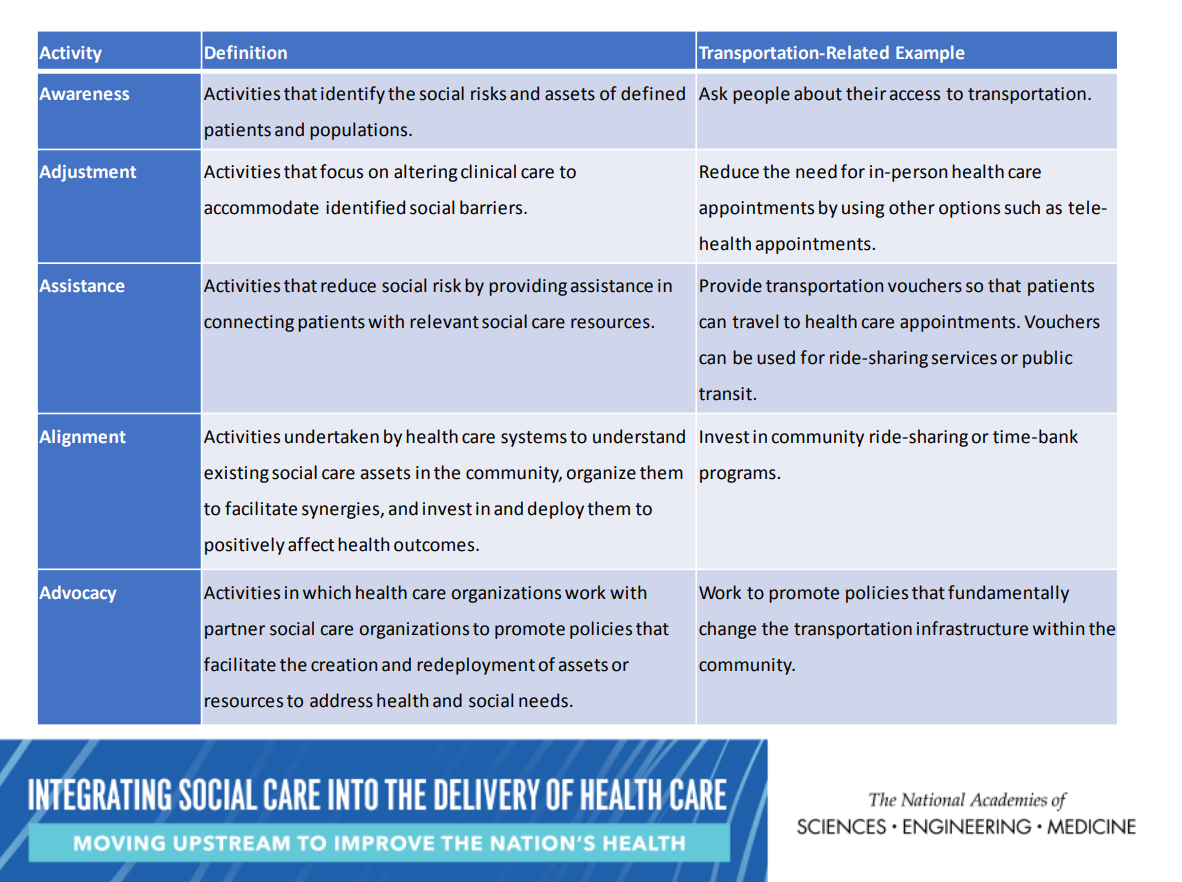
Share On Social!
Your health depends on the social conditions where you live—like stable housing, safe transportation, and health food.
But the health care system often overlooks these social conditions in favor of medical interventions.
To improve the nation’s health, health care leaders should integrate social care into health care delivery.
“Integrating social care into health care delivery holds the potential to achieve better health outcomes for the nation and address major challenges facing the U.S. health care system,” according to a new report from the National Academies of Sciences, Engineering and Medicine (NASEM).
Policymakers, health system leaders, and other stakeholders can achieve this integration through 10 key actions.
5 Goals to Integrate Social Needs into Health Care
The report, Integrating Social Care into the Delivery of Health Care: Moving Upstream to Improve the Nation’s Health, identified five goals to better integrate social care into health care.
Each of the following five goals is supported by a series of recommendations and steps:
- Design health care delivery to integrate social care into health care. For instance, organizations should implement integrated care systems by engaging a wide variety of stakeholders. They can also establish linkages and communication pathways between health care and social service providers.
- Build a workforce to integrate social care into health care delivery. For instance, systems should include social care workers as the standard, and considered as providers eligible for reimbursement by payers. Training for health professionals should include knowledge of social factors and how they affect health.
- Develop a digital infrastructure that is interoperable between health care and social care organizations. For instance, the federal government should establish a large-scale social care digital infrastructure and provide resources so that social care organizations and consumers can interact with each other and the health care system.
- Finance the integration of health care and social care. For instance, the Centers for Medicare & Medicaid Services should clearly define which aspects of social care Medicaid can pay for as covered services.
- Fund, conduct, and translate research and evaluation on the effectiveness and implementation of social care practices in health care settings. For instance, federal and state agencies, payers, providers, delivery systems, and foundations should contribute to advancing research on and evaluating the effectiveness and implementation of social care practices.

These goals need three elements to work appropriately:
- Interprofessional teams of social workers, community health workers, nurses, physicians, family caregivers, gerontologists, lawyers, and others have a role in carrying out awareness, adjustment, assistance, alignment, and advocacy activities.
- The application of new digital tools can potentially improve efforts by health care systems and their social care partners to address health-related social needs via the five key activities.
- The legal definition of health care can affect which social care activities can be included in health care services, thus the prevailing fee-for-service model does not align incentives for providing social care with health care.
5 Activities to Integrate Social Needs into Health Care
The report also identified five activities to better integrate social care into health care:
- Awareness activities: Identify the social risks and assets of defined patients and populations.
- Adjustment activities: Alter clinical care to accommodate identified social barriers.
- Assistance activities: Reduce social risk by connecting patients with social care resources.
- Alignment activities: Enable health care systems to understand their communities’ existing social care assets, facilitate synergies, and invest in and deploy them to positively affect health outcomes.
- Advocacy activities: Bring together as partners health care and social care organizations to promote policies that facilitate the creation and redeployment of resources to address health and social needs.
The specific types of activities that are undertaken will vary across and within health care settings and by the social factors being addressed.
Transportation is one example.
Doctors and nurses who ask patients about their access to transportation is an awareness activity and is critical to understand the social risks and assets of defined patients and populations. Providing transportation vouchers is an assistance activity to help patients get to their medical appointments.
“While all of the activities will ultimately benefit patients, adjustment and assistance focus on improving care delivery provided specifically to individual patients based on information about their social needs,” according to the report.
Share this report using the social media toolkit.
Taking Social Care to the Next Level: Changing Communities
Although mediating individual social needs, such as providing transportation vouchers, will help improve health and lower costs, these efforts will only achieve short-term, individual gains. That’s because they don’t address the root causes of poor health.
Individual transportation needs, for example, extend beyond medical care.
Transportation is a particularly influential social factor because it is connected to numerous other social factors, such as access to quality child care, affordable housing, employment opportunities and nutritious food.
That’s where advocacy activities come in.
 Working to promote policies that fundamentally change the transportation infrastructure within the community is an advocacy activity and has the potential to improve health for more people while also improving other social factors.
Working to promote policies that fundamentally change the transportation infrastructure within the community is an advocacy activity and has the potential to improve health for more people while also improving other social factors.
Through advocacy activities, the health care sector can play a bigger role in influencing and investing in multimodal transportation networks to prevent the emergence of unmet transportation needs.
“Work to promote policies that fundamentally change the transportation infrastructure within the community,” according to the report.
A good start on the path to advocacy is the Salud America! Health Equity Report Card.
This tool enables you to identify local gaps in social needs and health inequities with helpful maps, data, and gauges.
GET YOUR HEALTH EQUITY REPORT CARD!
By The Numbers
25.1
percent
of Latinos remain without health insurance coverage



